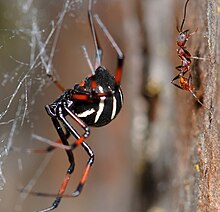Latrodectus variolus
| Latrodectus variolus | |
|---|---|

| |
| Female | |

| |
| Male (with damaged legs) | |
| Scientific classification | |
| Domain: | Eukaryota |
| Kingdom: | Animalia |
| Phylum: | Arthropoda |
| Subphylum: | Chelicerata |
| Class: | Arachnida |
| Order: | Araneae |
| Infraorder: | Araneomorphae |
| Family: | Theridiidae |
| Genus: | Latrodectus |
| Species: | L. variolus
|
| Binomial name | |
| Latrodectus variolus Walckenaer, 1837[1]
| |
Latrodectus variolus, the northern black widow spider or northern widow, is a medically important spider species of the genus Latrodectus in the family Theridiidae. The population is closely related to the southern black widow, Latrodectus mactans, and the western black widow, Latrodectus hesperus, of the genus.[citation needed]
It is commonly found in Middle Atlantic states (New Jersey, Delaware, Maryland). During the April–May mating season, it can travel north along the coast as far as Massachusetts. It also occurs in Connecticut in late summer. It is found, rarely, in southern Ontario, Canada, and in Southeastern Michigan. [citation needed]
A bite may cause latrodectism, and requires medical attention in the case of increasingly severe discomfort or spreading local redness accompanied by severe pain.[2] The LD-50 has been measured in mice as 1.20–2.70 mg (0.019–0.042 gr); each spider contains about 0.254 mg (0.0039 gr) of venom.[3]
Unlike for the related Latrodectus mactans, as of 2015[update] no antivenom was available.[citation needed]
References
- ^ "Taxon details Latrodectus variolus Walckenaer, 1837", World Spider Catalog, Natural History Museum Bern, retrieved 2016-04-26
- ^ CalPoison.org
- ^ McCrone, J.D. (December 1, 1964). "Comparative lethality of several Latrodectus venoms". Toxicon. 2 (3): 201–203. doi:10.1016/0041-0101(64)90023-6.
External links
 Data related to Latrodectus variolus at Wikispecies
Data related to Latrodectus variolus at Wikispecies
